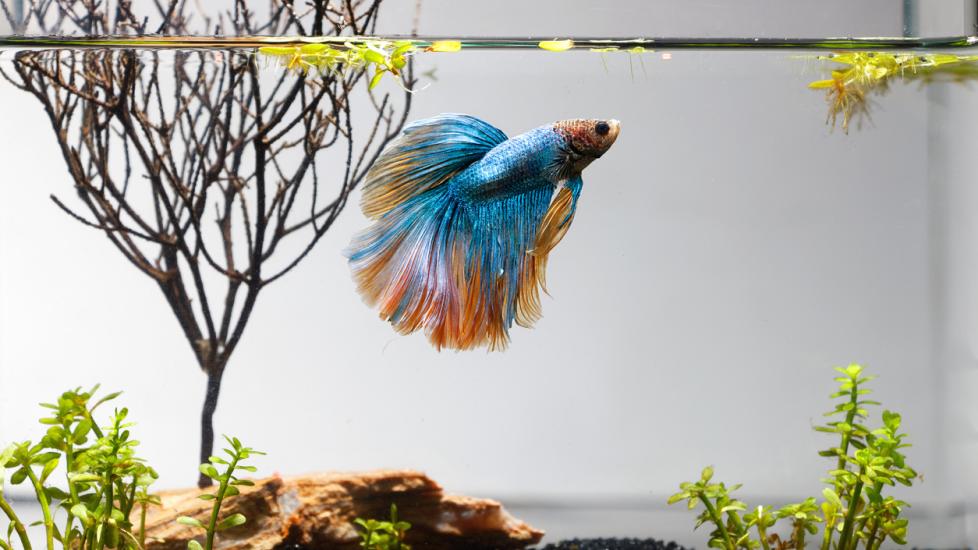7 Betta Fish Facts: Lifespan, Origin, and More
iStock/CmErsoy
Betta fish (Betta splendens), also called Siamese fighting fish, are one of the most popular freshwater aquarium fish in the world due to their beautiful colorations, various fin shapes, and their relative ease of care.
If you are looking into keeping ornamental fish, bettas can be a great option. There are over 70 different types of bettas that have been selectively bred for specific traits, including fin appearance, pattern, and coloration.
Learn more about these cool fish with these interesting betta fish facts.
Betta Fish Facts
1. The Betta Fish Lifespan Is 3–5 Years
One of the most common questions about betta fish is “how long do betta fish live?” While betta fish typically live 3–5 years, some of the oldest betta fish ever recorded lived to the age of 10.
Betta fish lifespan can be maximized when they are kept in ideal environments with proper care. With improper care, bettas are more susceptible to developing diseases or illness, which can shorten their lifespan considerably.
2. Betta Fish Can Reach 2.5 Inches Long
Next, you may wonder how big betta fish get. Most betta fish will reach about 2.5 inches long as adults, not including their tails.
There are many betta fish types, which will determine how long their tails can be. For example, feather tail bettas will have long tail fins, while their cousins the spotfin bettas will have shorter tails.
3. Bettas Need 10- to 20-Gallon Tanks
Recreating the betta fish natural habitat should be the top priority when keeping them in an aquarium within your house. It’s important to consider a large enclosure when planning to keep a betta.
The minimum enclosure size for a single betta is 10 gallons. However, larger tanks are even better for visual appeal. For example, 20-gallon tanks will allow you to provide lots of decorative enrichment for your bettas and their tank mates.
Planted tanks with decorations such as rocks and driftwood can provide a great ecosystem for your betta.
Depending on how many bettas you keep in an enclosure, each fish should have about 5 gallons of space.
It’s not recommended to keep bettas in bowls.
4. Betta Fish Are Native to Asia
So where are betta fish from? Bettas originally come from Southeast Asia and can be found in:
-
Thailand
-
Vietnam
-
Myanmar
-
Laos
-
Cambodia
-
Indonesia
-
Malaysia
Bettas are freshwater fish, and they generally live in shallow areas like rice paddies and marshes.
5. Bettas Are Called Fighter Fish
Bettas are known as fighting fish due to the territorial nature of male bettas. Territory aggression commonly happens in the wild when ponds containing bettas dry up. Bettas become isolated within smaller ponds and fight with one another.
When the fish’s aggressive nature was discovered, humans used betta fish as a form of entertainment. Similar to cockfighting matches, people would bet on these matches and the fish would often fight to the death.
There are over 70 different types of bettas that have been selectively bred for specific traits, including fin appearance, pattern, and coloration.
Bettas continued to be bred for these aggressive traits over many years. Fighting became so popular that the King of Siam started to regulate these fights to collect some of the winnings and owned personal fighting fish.
Bettas were one of the first fish species to be domesticated about 1,000 years ago. During the 19th century, they were introduced to western civilizations and became one of the most popular ornamental fish species.
6. Female Bettas Can Live With Other Fish
Bettas are considered one of the most aggressive freshwater fish. It is not recommended to keep male betta fish together in the same tank. If males are kept together, they will likely fight until the death.
However, female bettas can be housed together because they are not territorial like males and will often form docile groups.
Depending on the space you provide, pet parents can keep three to five female bettas together. Females should be kept in odd numbers because they often develop a dominance hierarchy within their group.
Keeping other fish with bettas depends on the size of the tank. The larger the tank, the more fish can be kept together.
Species that can be kept with bettas include:
-
Blue gourami
-
Pictus catfish
-
Other bottom dwelling fish
Other animals that can live harmoniously with bettas include African dwarf frogs.
7. Betta Fish Need High-Protein Food
Bettas are carnivores so their diet should be high in protein. In the wild, they eat small insects and larvae.
In captivity, high-protein floating fish pellets are recommended for betta fish.
It's recommended not use fish flakes to feed bettas because many fish may not accept them as food and they may not eat enough flakes to support themselves.
Occasional treats can include brine shrimp, krill, and bloodworms.
Bettas should be fed once a day, and generally may be fed two to three pellets at one time. Feeding enough pellets to take up the space of one fish eyeball is a good approximation. Depending on the brand it could vary from 10–12 pellets or one to two pellets.
Remember, overfeeding a betta can have adverse effects on the water quality within the environment as any uneaten food builds up on the bottom of the habitat. Filtration systems can help remove some of this waste.
